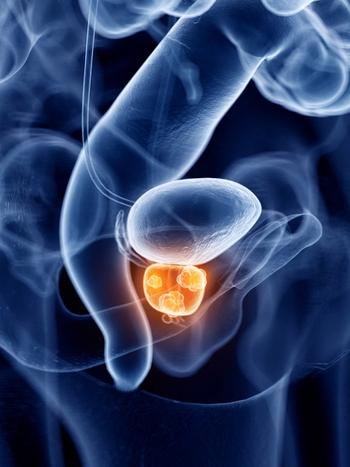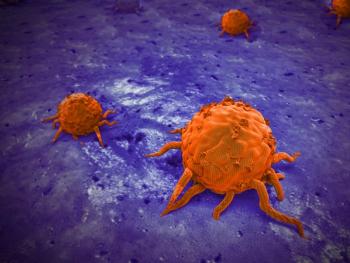
Prostate Cancer
Latest News
Latest Videos

Podcasts
CME Content
More News

Results from the phase 3 ARANOTE trial demonstrated a statistically meaningful improvement to rPFS with darolutamide vs placebo.

The addition of CAN-2409 to a prodrug and radiation therapy in intermediate-to-high-risk prostate cancer significantly improved cancer-specific outcomes.

Niraparib plus abiraterone acetate and prednisone significantly reduced the risk of symptomatic progression in patients with BRCA-mutated metastatic castration-sensitive prostate cancer.

SBRT did not significantly impact response when added to nivolumab/ipilimumab for patients with mCRPC.

Full results from the phase 3 trial supporting CAN-2409 plus valacyclovir and radiation therapy in this indication will be presented at the 2025 ASCO Annual Meeting.

Decipher Prostate, Oncotype DX, and Prolaris are 3 gene expression testing options for patients with prostate cancers. Read as experts discuss them.

Eight votes were cast against the favorability of talazoparib and enzalutamide in the first-line setting for patients with metastatic castration-resistant prostate cancer.

Following a positive meeting with the FDA, PT-112 is set to advance to a phase 3 trial for patients with metastatic castration-resistant prostate cancer.

Findings from prior studies, such as the phase 3 VISION trial, may support the notion of combining radiopharmaceuticals with best supportive care.

Beta emitters such as lutetium Lu 177 rosopatamab may offer built-in PSMA imaging during the treatment of patients with metastatic castration-resistant prostate cancer.

The 1.5T Elekta Unity MR-Linac demonstrated lower rates of erectile dysfunction with neurovascular sparing vs without in patients with intermediate-risk prostate cancer.

Panelists discuss how PSMA PET imaging is expected to evolve, enhancing precision in prostate cancer treatment through improved detection and staging. Medical professionals anticipate broader use in therapy guidance, with future advancements addressing gaps in early detection and metastasis, improving treatment strategies.

Panelists discuss how, Copper-64 (^64Cu)–labeled PSMA-targeted PET imaging is emerging as a promising modality in prostate cancer diagnosis. The phase 2 SOLAR study (NCT05653856) demonstrated that ^64Cu-PSMA I&T PET/CT effectively detects metastatic prostate cancer, meeting primary end points related to correct localization rates. Compared with gallium-68 (^68Ga) and fluorine-18 (^18F), ^64Cu offers a half-life of approximately 12.7 hours, facilitating centralized production and distribution, which may improve accessibility

A recommendation from an independent data monitoring committee prompted the discontinuation of the phase 3 CAPItello-280 trial.

Data show that patients who undergo grade group 1 prostatectomies may experience an increased likelihood of higher risk features.

BMI, serum albumin, and G8 screening tool scores were all factors correlated with the likelihood of experiencing a grade 3 or higher AE.

Toxicity complications were assessed between single- and multiple-treatment modalities for patients with localized prostate cancer.

Panelists discuss how PSMA PET imaging identified a region of high tracer uptake, guiding medical professionals to implement a focal radiation boost. This approach improved treatment precision and targeting of aggressive areas, highlighting the potential for personalized, effective therapies.

Panelists discuss how PSMA PET imaging has significantly influenced prostate cancer management by enabling precise detection of metastatic lesions, thereby informing and altering treatment strategies. For instance, a study demonstrated that ^68Ga-PSMA-11 PET/CT impacted definitive radiation therapy (RT) planning in 16.5% of patients, leading to modifications in RT fields based on the imaging findings.

Administering 177Lu for mCRPC is a “team sport”, according to Steven Finkelstein, MD, DABR, FACRO.

Panelists discuss how PSMA PET imaging is increasingly utilized to assess treatment response in prostate cancer, offering superior accuracy over PSA monitoring alone. Incorporating PSMA PET into clinical practice involves considering factors such as timing post treatment and the specific clinical scenario. For instance, studies have demonstrated that PSMA PET/CT can detect intraprostatic and metastatic lesions even at very low PSA levels during treatment monitoring.

After the recent approval of 177Lu in PSMA+/mCPRCP prior to chemotherapy, Steven Finkelstein, MD, DABR, FACRO, highlights the importance of this milestone.

Results from the KEYNOTE-921 trial demonstrated that pembrolizumab with docetaxel did not elicit efficacy improvements vs placebo with docetaxel in prostate cancer.

Prolaris in Practice: Guiding ADT Benefits, Clinical Application, and Expert Insights From ACRO 2025
Steven E. Finkelstein, MD, DABR, FACRO discuses how Prolaris distinguishes itself from other genomic biomarker platforms by providing uniquely actionable clinical information that quantifies the absolute benefit of androgen deprivation therapy when added to radiation therapy, offering clinicians a more precise tool for personalizing prostate cancer treatment strategies.

Alvaro Martinez, MD discusses how emerging genomic risk stratification tools such as the clinical cell-cycle risk (CCR) score are transforming personalized prostate cancer treatment by enabling more nuanced assessments of metastasis risk and treatment intensification strategies beyond traditional NCCN risk groupings.


![A retrospective study shows that [177Lu]Lu-PSMA-617 retreatment led to a median OS of 14.5 months in castration-resistant prostate cancer.](https://cdn.sanity.io/images/0vv8moc6/cancernetwork/f5ef402e3456a83ca4765506f26761d323734d14-446x339.jpg)


























































































